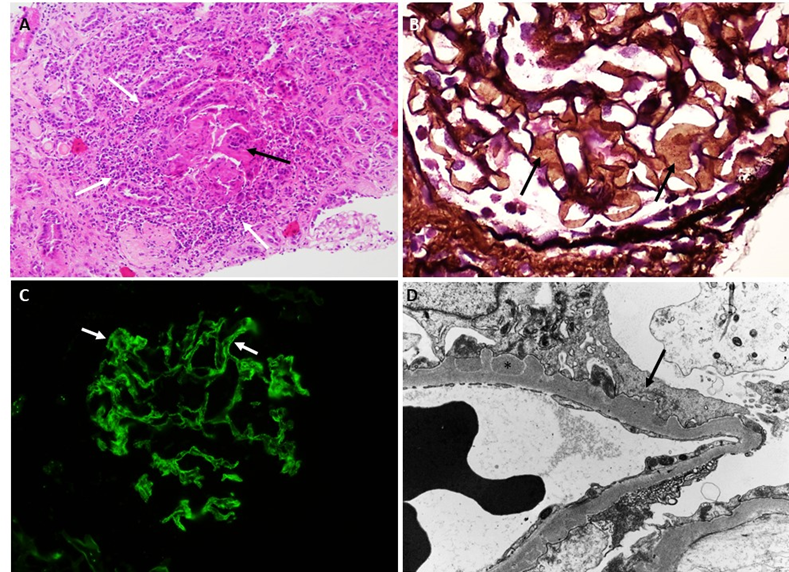NephroQuiz: a fishy rash.
Published in General & Internal Medicine

A 51-year-old man presented for evaluation of a newly developed rash (xerosis with hyperpigmented scaly lesions on his arms, legs, abdomen, and back). Skin biopsy showed hyperkeratosis with non-necrotising granulomas. He had no medical history, did not report any nausea, vomiting, chest pain, dyspnea, or urinary symptoms. On examination his blood pressure was 125/75 mmHg, pulse rate was 85 beats per minute, and his oxygen saturation was 96%.
Laboratory investigations showed creatinine 6.27 mg/dL (normal range 0.67–1.17; a baseline measurement 2 months before he presented was 0.9), sodium 137 mmol/L (normal range 136–145), potassium 3.8 mmol/L (normal range 3.5–5.1), bicarbonate 22 mmol/L (normal range 22–29), calcium 15.1 mg/dL (normal range 8.6–10.2), albumin 4.3 g/dL (normal range 3.5–5.2), ionized calcium 1.91 mmol/L (normal range 1.17–1.38), parathyroid hormone (PTH) 9.1 pg/mL (normal range 18.4–80.1), PTH-related protein 3.4 pmol/L (normal range 0.0–2.3), 1,25-dihydroxyvitamin D 97.3 pg/mL (normal range 19.9–79.3), and angiotensin-converting enzyme 120 U/L (normal range 16–85).
Urinalysis was positive for proteinuria with a urine protein-to-creatinine ratio of 0.92. Further serology workup showed the following: negative hepatitis B virus, hepatitis C virus, and HIV serologies, normal C3 and C4, undetectable antinuclear antibodies (ANAs), anti-double stranded DNA antibodies titer of <1:10 (normal <1:10), negative antineutrophil cytoplasmic antibodies (ANCAs), serine protease 3 antibodies (PR3-ANCAs) titer of 0 AU/mL (normal 0–19), myeloperoxidase antibodies (MPO) titer of 0 AU/mL (normal 0–19), and phospholipase A2 receptor (PLA2R) antibody titer of <1:10 (normal <1:10).

Kidney biopsy (shown above) was performed with: light microscopy hematoxylin and eosin stain (A), light microscopy periodic acid methenamine silver stain (B), IgG Immunofluorescence microscopy (C), electron microscopy (D).
The correct answer and explanation will be revealed once you select an answer in the multiple choice question above.
Click here to read the original case report. We encourage discussion of the case and questions in the comments.
Follow the Topic
-
BMC Nephrology

This is an open access journal publishing original peer-reviewed research articles in all aspects of the prevention, diagnosis and management of kidney and associated disorders, as well as related molecular genetics, pathophysiology, and epidemiology.
Related Collections
With Collections, you can get published faster and increase your visibility.
Biomarkers in kidney disease diagnosis
BMC Nephrology is calling for submissions to our Collection on Biomarkers in kidney disease diagnosis.
Kidney disease remains a pressing global health issue, affecting millions and often leading to significant morbidity and mortality. The identification of reliable biomarkers has emerged as a promising avenue for enhancing the diagnosis and management of kidney diseases. Biomarkers can provide critical insights into the pathophysiology of renal conditions, facilitate early detection, and help tailor treatment strategies to individual patients. With the advent of advanced technologies in molecular biology and genomics, there is a growing interest in understanding how specific biomarkers can improve clinical outcomes in kidney disease.
The significance of advancing biomarker research in kidney disease diagnosis is underscored by recent breakthroughs in the identification of novel biomarkers that improve accuracy and timeliness in detection. These advancements are crucial for the early intervention and management of chronic kidney disease (CKD) and acute kidney injury (AKI). As research continues to evolve, integrating biomarkers into clinical practice can revolutionize the way kidney diseases are diagnosed, monitored, and treated. Furthermore, innovative biomarker applications may allow for better stratification of risk in populations at high risk for kidney disease, paving the way for proactive health management strategies.
Topics of interest for this Collection include, but are not limited to:
Novel biomarkers for kidney disease diagnosis
Early detection methods in kidney pathology
Clinical applications of renal biomarkers
Biomarkers and chronic kidney disease management
This Collection supports and amplifies research related to SDG 3 (Good Health and Well-being) and SDG 9 (Industry, Innovation, and Infrastructure).
All manuscripts submitted to this journal, including those submitted to collections and special issues, are assessed in line with our editorial policies and the journal’s peer review process. Reviewers and editors are required to declare competing interests and can be excluded from the peer review process if a competing interest exists.
Publishing Model: Open Access
Deadline: Jan 30, 2026
Images in nephrology
BMC Nephrology is calling for submissions to our Collection on Images in nephrology.
This will be a unique collection where all submissions to the collection that meet consideration criteria will be included in an image competition. The Guest Editors for this collection will be the referees and will judge each image based on pre-defined criteria. We welcome submissions in the form of case reports, commentary articles and literature reviews to present their image. All images relating to the vast field of nephrology will be considered for publication and participation in the competition. The winner will receive a full APC waiver for their submission and for one future publication in BMC Nephrology. The second and third place winners will receive a full APC waiver for their submission to the collection. 1st and 2nd place winners will be invited to contribute to the BMC Nephrology blog. All winners will also be eligible for an invitation to BMC Editors Day – to visit a Springer Nature location and meet editorial staff.
Inspired by the multidisciplinary nature of our field, we want to welcome submissions that highlight the beauty of day-to-day nephrology. Intraoperative images, laboratory photographs, microscopy findings, anatomical models, hand-drawn art, radiology images and more will be considered. The image should be accompanied by a case report, commentary or review, describing the findings and importance of the image, the case or story behind it. Novelty will not be a criteria for consideration. Patient images are required to have appropriate patient consent for publication. Images accompanied by commentary and submitted as commentary articles will be considered on a case-by-case basis. Literature reviews will be considered pending editorial approval. In order to be published and considered in the competition, the articles must abide by scholarly publishing standards and journal guidelines.
The judges will evaluate the images based on, but not limited to, the following:
Image uniqueness
Adherence to BMC Nephrology scope
Quality and content of the image
Educational and public interest
Case and story behind the image
Submissions will be assessed for adherence to journal guidelines and publishing standards. Manuscripts that are rejected will be withdrawn from the competition automatically. If a manuscript is accepted, it will participate in the final evaluation by judges. All accepted manuscripts will be embargoed until the judging is completed. We will aim to carry out final judging quickly, as to not delay the publication of submitted works. The final day to submit a manuscript for consideration in the image contest will be November 1st, 2025. Final results will be tallied by November 30th, 2025 and the winners will be announced shortly after. The winners will be provided with an APC waiver immediately. All submitted manuscripts will undergo standard peer review and editorial evaluation as necessary.
All manuscripts submitted to this journal, including those submitted to collections and special issues, are assessed in line with our editorial policies and the journal’s peer review process. Reviewers and editors are required to declare competing interests and can be excluded from the peer review process if a competing interest exists.
Publishing Model: Open Access
Deadline: Dec 31, 2025




Please sign in or register for FREE
If you are a registered user on Research Communities by Springer Nature, please sign in